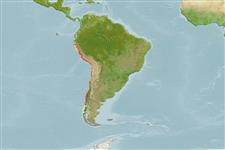Teleostei (teleosts) >
Ophidiiformes (Cusk eels) >
Ophidiidae (Cusk-eels) > Ophidiinae
Etymology: Genypterus: Greek, geny, -yos = face, jaw + Greek, pteron, = wing, fin (Ref. 45335).
More on author: Guichenot.
Issue
Needs a taxonomic reference.
Environment: milieu / climate zone / depth range / distribution range
Ecology
Marine; bathydemersal. Deep-water; 6°S - 54°S, 82°W - 70°W (Ref. 34024)
Southeast Pacific: southern Peru to southern Chile.
Size / Weight / Age
Maturity: Lm ? range ? - ? cm
Max length : 150 cm SL male/unsexed; (Ref. 34024)
Short description
Identification keys | Morphology | Morphometrics
Common species inhabiting rocky bottom in deep shelf and upper slope waters (Ref. 34024). Oviparous, with oval pelagic eggs floating in a gelatinous mass (Ref. 205).
Life cycle and mating behavior
Maturity | Reproduction | Spawning | Eggs | Fecundity | Larvae
Nielsen, J.G., D.M. Cohen, D.F. Markle and C.R. Robins, 1999. Ophidiiform fishes of the world (Order Ophidiiformes). An annotated and illustrated catalogue of pearlfishes, cusk-eels, brotulas and other ophidiiform fishes known to date. FAO Fish. Synop. 125(18):178p. Rome: FAO. (Ref. 34024)
IUCN Red List Status (Ref. 130435: Version 2025-1)
Threat to humans
Harmless
Human uses
Fisheries: commercial
Tools
Special reports
Download XML
Internet sources
Estimates based on models
Preferred temperature (Ref.
123201): 7.1 - 11, mean 8.8 °C (based on 22 cells).
Phylogenetic diversity index (Ref.
82804): PD
50 = 0.5156 [Uniqueness, from 0.5 = low to 2.0 = high].
Bayesian length-weight: a=0.00257 (0.00122 - 0.00544), b=3.17 (2.98 - 3.36), in cm total length, based on LWR estimates for this (Sub)family-body shape (Ref.
93245).
Trophic level (Ref.
69278): 3.9 ±0.74 se; based on food items.
Resilience (Ref.
120179): Low, minimum population doubling time 4.5 - 14 years (Assuming tm>4).
Fishing Vulnerability (Ref.
59153): Very high vulnerability (90 of 100).
🛈
Climate Vulnerability (Ref.
125649): Very high vulnerability (88 of 100).
🛈
Nutrients (Ref.
124155): Calcium = 13.5 [8.3, 29.9] mg/100g; Iron = 0.374 [0.192, 0.717] mg/100g; Protein = 15.3 [13.4, 17.4] %; Omega3 = 0.227 [0.125, 0.443] g/100g; Selenium = 24.9 [11.0, 55.9] μg/100g; VitaminA = 9.46 [2.03, 45.50] μg/100g; Zinc = 0.297 [0.195, 0.454] mg/100g (wet weight);
